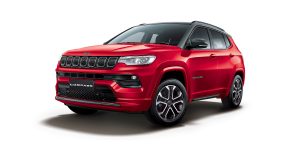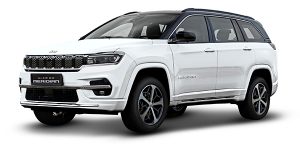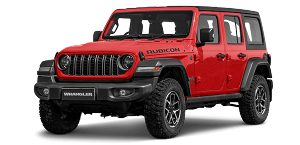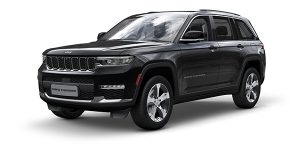1960-1969
The all-new Jeep® Wagoneer represented unparalleled refinement and innovation. Prestige and individuality ruled the day. The Jeep brand line-up grew to include 14 models — for work, play, recreation and luxuriously capable transportation.
Introduction to a Design classic
The 1960s introduced the Jeep® Wagoneer in 1962 an instant classic designed by Brooks Stevens and advertised as “All-New, All-Jeep®.” It featured the first automatic transmission and independent suspension in a 4x4 vehicle. The Gladiator pickup truck was introduced as a “beautiful brute.” A new “Dauntless” V6 engine in the CJ-5 and Cj-6 doubled the power of previous engines.
Inspired Design Continues
1961-1965 FLEETVAN (FJ-3/FJ-3A)
Walk-in Delivery Van
Willys Motors introduced the two-wheel drive Fleetvan was designed for light-duty, multi-stop applications such as postal delivery and ice-cream trucks. Practical was the operative word for the FJ platform. The Fleetvan was built on a beefed up DJ-3A Dispatcher platform and retained the same tough “Jeep” 81-inch wheelbase and F-134 Hurricane F-head engine. The FJ-Series was efficient, rugged and highly maneuverable.
Jeep® Fleetvan.
This step-van featured sliding doors that were easy to enter from either side. Maximum use of front windshield glass permitted “all-points” vision for the driver thanks to its cab-over engine design.
Jeep® Fleetvan.
The first version was a right-hand-drive U.S. Post Office model that allowed the driver to operate the vehicle standing up for easier operation.
Jeep® Fleetvan postal truck.
The slightly longer FJ-3A featured a long overhang with an overall length of 154-inches (vs 135 inches for the FJ-3).
Jeep® Fleetvan Commercial Van.
In 1965, a new FJ-6 version was built on the CJ-6 platform. In 1975, the FJ-8 3/4-ton series and FJ-9-Series Postal Service vans built by AM General replaced the FJ-6.
Jeep® Fleetvan.
1963-1991 JEEP® WAGONEER (SJ)
First Luxury 4x4 SUV
In 1962, the Jeep® brand introduced the Wagoneer — the father of all luxury 4x4 SUV’s. Replacing the Willys utility wagon lines, the Wagoneer was designed to provide passenger-car styling, comfort, and convenience with the advantages of four-wheel drive (4WD).
1962 Jeep® Wagoneer
The revolutionary Wagoneer was filled with innovation and industry firsts: the first automatic transmission in a 4x4 vehicle; the first overhead-cam six-cylinder truck engine, the first 4x4 vehicle with an independent front suspension; the first automatic full-time 4x4 system. The revolutionary Quadra-Trac® 4x4 system, introduced in 1973, was available in full-size Jeep trucks and wagons, and later in the CJ-7.
1962 Jeep® Wagoneer
Styled by the famed industrial designer Brooks Steven, the Wagoneer captured the public imagination with its modern styling and good looks. The entire line of “Senior” (SJ) vehicles included the Gladiator and J-Series Trucks, Wagoneer Station Wagons, Panel Deliveries, and early Cherokee models.
1966 Jeep® Super Wagoneer
The SJ line was in production for more than 28 years with only minor technical changes and when production ended – was the longest continuous automotive production run, on the same platform, in U.S. automotive history.
1966 Jeep® Super Wagoneer interior.
The Wagoneer was renamed the Grand Wagoneer in 1984 to coincide with the introduction of the downsized Wagoneer and Cherokee (XJ) models.
1962 Jp Wagoneer rear rt
1963-1987 JEEP® GLADIATOR / J-SERIES TRUCK
Full-Size Pick-Up Trucks
In 1962 a completely new “J” line of Jeep Gladiator trucks were introduced for the 1963 model year. The Gladiator full-size pickup trucks shared the same platform, front-end styling, and powertrain as the Wagoneer.
1962 Jeep® Gladiator J-200 thriftside pick-up truck.
The Gladiator was available in either 120-inch (J-200) or 126-inch (J-300) form, and featuring a Dana 20 transfer case and Dana 44s front and rear. A tougher independent front suspension was available on half-ton trucks until 1965 but used a beefier 44IFS front differential.
Jeep Gladiator pickup truck.
Available configurations included: Thriftside (narrow box), Townside (wide box), Chassis or Cab; Stake Bed; Wrecker; and Chassis-mounted campers with extended wheelbases.
1960s-Pillar-Jeep-Gladiator-J-Series
In late 1965, the J-200 and J-300 Gladiators became known as the J-2000 and J-3000 respectively. The Gladiator name was dropped in 1971, after which the pickup line was known as the J-Series through 1987. In 2005, a new Gladiator concept vehicle was introduced as a prototype for the possible direction the Jeep brand might take in the near future.
1964 Jeep® Gladiator truck with hydraulic dump bed option.
1964-1967 JEEP® CJ-5A/CJ-6A TUXEDO PARK
Dressed up CJ
The Jeep® Tuxedo Park IV was a luxury special edition vehicle available on CJ-5A and CJ-6A vehicles produced from 1964-1967.
1964 Jeep® Tuxedo Park Mark IV.
Tuxedo Park IV models included a chrome front bumper, hood badges, windshield hinges, tail lamps, hubcaps with “Jeep” emblem, and column shift, four-wheel drive and a 160 horsepower V6 engine option. Jeep CJ-5A Tuxedo Park’s were used in Lyndon B. Johnson’s inaugural presidential parade in 1965.
1964 Jeep® Tuxedo Park Mark IV.
1965-1971 JEEP® J-2000 & J-3000 SERIES PICKUP (SJ)
Powerful and Tough Jeep® Trucks
In late 1965, the J-200 and J-300 Gladiators became known as the J-2000 and J-3000 respectively. The J-2000 featured a 120-inch wheelbase, and the J-3000 had a 126-inch wheelbase. They were available in two or four-wheel drive configurations.
1968 Jeep® Gladiator J-3000 pick-up truck.
The J-Series Truck featured two great engines: the now standard Jeep® Hi-Torque 6, and the optional Vigilante V-8. You can get the Turbo-Hydra-Matic® automatic transmission along with a new, improved 4-wheel drive shift system and dual-range transfer case, new improved steering, optional full-time power steering, variable-rate rear springs … plus spirited new paint and trim options.
1965 Jeep Gladiator truck.
In 1968, the J-3000 Truck (126-inch) featured stout Dana 44 front and Dana 53 axles with 4.27:1 standard gear and 350 cubic inch “Dauntless” V8 (Buick) engine and 4-speed transmission.
1960s-Pillar-J-2000-J-3000-Serieis-Pickup
1969-1974 JEEP® GLADIATOR / J-4000 SERIES PICKUP (SJ)
Standard 4x4 for Major Work and Fun
The J-4000 Series pickup featured a new front clip, along 131-inch wheelbase. This brute featured a 19 spline Dana 44 front axle with D44, D53 or D60 rear. The standard powerplant was the 232 V6 engine. Engine options included the AMC 360 V8 and AMC 401 V8. In 1971, the Jeep Gladiators were the only U.S. pickups to have four-wheel drive as standard and were completely at home in the toughest roughest country. Available options included a power takeoff, dumper body, snowplow, wrecker package, and front-mounted winch.
1968 Jeep® Gladiator J-3000 pick-up truck.
A J4800 Camper Special edition was available that could mount a living-space camper on the truck pickup body. This package featured a payload capacity of 3930 pounds, extra-heavy-duty suspension, four-speed all-synchro transmission, heavy-duty cooling and 10-ply tires.
1970_Jp_Gladiator_pickup_camper
1966-1969 JEEP® SUPWER WAGONEER (SJ)
A “Super-Custom” Wagoneer
In 1965, the Jeep® brand introduced the refined Super Wagoneer – a true luxury 4x4. Also known as the “Super Custom,” the upscale Wagoneer was designed for the prestige buyer who desired rugged versatility with sedan comfort. It featured a single-speed transfer case for all-weather capability.
1967 Jeep® Super Wagoneer.
Super Wagoneer sported many premium features including: air conditioning, power tailgate, power brakes, power steering, seven-position tilt steering wheel, tinted windows, three-tone body striping, vinyl roof, padded vinyl roof with chrome roof-rack, full wheel hubcaps, white-walled tires, powerful 327-cubic inch “Vigilante” four-barrel V8 engine (270 hp) with console-shifted TH400 “Turbo Hydra-Matic” automatic transmission – all standard.
1966 Jeep® Super Wagoneer.
With this high level of standard equipment, Super Wagoneer paved the way for the burgeoning luxury Sport Utility Vehicle (SUV) market of today. The $5,943 MSRP was almost double that of the base Wagoneer, which set it apart from the masses.
1966 Jeep® Super Wagoneer.
1975 marked the introduction of the “woody treatment, a wood grain appliqué, a look that became synonymous with later Wagoneer’s.
1966 Jeep® Super Wagoneer trunk.
1967-1969 M-715
Viet-Nam Era Military Pick-Up Truck
The M-715 series 1 1/4-ton military Jeep® vehicle was designed to replace the Dodge M37 series 3/4-ton vehicles that had been in military service since 1951. The M-715 was an adaptation of the Gladiator pickup truck, becoming the first tactical vehicle built primarily from civilian components.
Jeep M-715 cargo truck.
The M-715 featured an inline 6-cylinder I-6 “Tornado” engine, T-98 four-speed transmission, NP200 transfer case with low range, Dana 60 front and Dana 70 full-floating rear axle with 5.87:1 axle ratio. Top speed was 55 mph.
Jeep M-715 at Camp Jeep.
The front grille fenders, hood, doors and cab were stamped from Gladiator dies, with modifications to the upper part of the cab and doors as well as the fender cutouts. The cargo box was an entirely military design.
Jeep M-715 at Camp Jeep.
The M-715 came in several variations, all built on the same frame and wheelbase: the M-724 cab & chassis model, equipped with a welder, generator, and 8,000-pound winch; the M-725 standard army ambulance, the M-726 telephone maintenance truck with 8,000-pound PTO winch, and spotlight mounted on the left corner of the cowling. Non-military government agencies also used the M-715 as well, including: fire, forestry, and fish/game departments.
M-715 cargo truck.
1967-1973 JEEPSTER COMMANDO (C-101)/(C-104)
A New Jeep 4x4 for Fun and Adventure
During the late 1960s, Kaiser detected a growing interest in leisure time use of 4x4 vehicles and capitalized on it with the introduction of a new series called Jeepster Commando. Kaiser Jeep borrowed the names of the Willys Jeepster and the Willys Commando Fire Truck for this sporty vehicle, designed to compete with the Bronco and Land Cruiser.
1967 Jeep® Jeepster Commando.
Launched with a youthful ad campaign promising seaside fun, the Commando was the first compact 4WD vehicle with automatic transmission and sported an interior “designed to handle the elements and impress the ladies on the beach.”
1967 Jeep® Jeepster Commando.
The C-101 (101-inch wheelbase) was built on a CJ-6 chassis with four body options – roadster, pickup, power-top convertible, and station wagon (8705F).
1967 Jeep® Jeepster Commando.
Long a favorite among the Jeep® brand faithful, early versions of the Commando came with many desirable components, including the “Dauntless” V6, optional TH400 transmission, and full floating Dana 27 front and 44 rear axles. One of the rarest of rare Jeep vehicles is the 1971 Commando “Hurst Special,” a AMC / Hurst joint promotion that featured a dual-gate Hurst shifter, ABS hoodscoop, 8,000 rpm racing tach, and blue and red exterior rally stripes. Fewer than 100 were ever produced and are much sought-after among collectors.
1968 Jeep® Jeepster Commando.
Two versions were built: the 1967-1971 Jeepster Commando (C-101) and the AMC-inspired Commando (C-104) of 1972-1973 (dropped Jeepster from name). Several special editions of the Jeepster Commando were produced. The Jeep brand produced the SC-1 or Sport Commando in 1971, which came standard with a V6 engine and included a special “Butterscotch” paint job and “speed stripes.” A similar version with revised sheet metal was offered in 1972 as the SC-2.
1971 SC-1 Jeepster Commando.
The Commando’s front end was restyled in 1972 to accommodate the AMC 232 and 258 OHV six-cylinder and 304 V-8 engines. Many feel the departure from the traditional Jeep grille brought on a quick demise for the Commando.
1972 Jeep® Jeepster Commando pickup.













